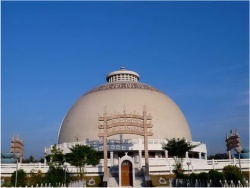Stupa is a sanskrit word
"Stupa is a sanskrit word and it is translated as "a knot or tuft of hair, the upper part of the head, crest, top, summit". In Rigveda texts stupa means "tree's stem". The root "stup" and the noun "stupa" was a living lexeme as evidenced by its derivatives in several languages distribuited over vast areas from Afghanistan to Lahndi in the eastermost region of India. Stupa is also a "pile-up of clay", meaning supported by its hindi derivatives. This is confirmed by the chinese traveller I-Tsing who visited India in the seventh century A.D. The word "stupa" can also be derived from "stup" which means "to raise well up, raise aloft, elevate". The word is also attested in Greek stupos "stem, stump, block. Compare the cognates in Latin stipes, stipa, stupeo, and in Lithuanian stups, stupe, pl. stupas. In Icelandic stupa is "tower". We can catch glimpses of the very beginning of the stupa as an element of the agricultural economy of early man. In its earliest stages it was a "tethering post" for an animal made out of a wooden stump to keep the animal in place. The animal was the symbol of wealth, Latin pecunia "money", originally property in cattle, from pecus "cattle". In its earliest form and function, the stupa represented a stabilisation of the socio-economic life of the comunity. The word tope for stupa was first introduced into English in 1839. It has three quite distinct origin. In the meaning of a buddhist monument: the word tope is in local use in the North-West Punjab, where ancient monuments of this kind occur, and appears to come from Sanskrit stupa, through the Pali or Prakrit thupo...The word was first introduced to European knowledge by Stewart Elphinstone in his account of the tope in Rawulpindi district, in the year 1839.
Monnier Williams, Sanskrit-English Dictionary, renders stupa as "a Buddhist monument, dagoba (generally of a pyramidal or dome-like form and created over sacred relics of the historical Buddha [563-478 b.C.] or on spots consecrated as the scenes of his acts); a relics shrine or relics casket. The stupa was originally a topknot of hair, designating the upper part of the head but subsequently became used as an architectural term, indicating a monument of a dome-shaped form over the sacred relics of the Buddha or other saints or venerable persons. With the growth of Buddhism in the course of time, the early structural model of stupa underwent gradual architectural trasformation in various regions of India and elsewere. Penetration of Buddhism in Sri Lanka, [[Wikipedia:Central Asian|Central Asian]], South-East Asian and East Asian countries besides Nepal and Tibet was followed by the trasmission of the religio-cultural traditions, concept, and form of Buddhist architecture including the stupa from their birth place to these foreign lands, where these were preserved , adapted and developed in accordance with local requirements, believes and taste."
